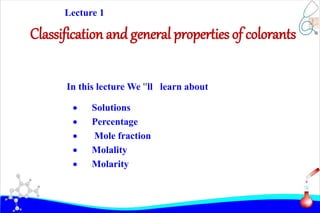
Experiment No. 2.pptx
- 1. Classification and general properties of colorants Solutions Percentage Mole fraction Molality Molarity In this lecture We ''ll learn about Lecture 1
- 2. • Theory • Reactive dye: • A class of colored synthetic organic chemicals that attach to textile fibers via a chemical reaction that forms a covalent bond. Reactive dyes are the most permanent of all dye types and are the most common type of dye used on cotton and other cellulose fibers. • . Exhaust Process: • Batch Process is the most popular and common method used for processing of textile materials. Batch process is also sometimes referred to as Exhaust Process. • • Equipment & Material: • Cotton fabric, wetting agent, weighing balance, pH meter, water bath, measuring cylinder, reactive dyes, soda ash, caustic soda, salt Title: Dyeing of 100% cotton fabric using reactive dyes in exhaust method and study the effect of salt on shade depth.
- 3. • Working Procedure: • Weigh all the chemicals and dyestuff according to the calculation w.r.t L:R. • Start dyeing at room temperature by putting fabric in the liquor • Wait for 15 minutes and add half the amount of salt calculated. • Let the temperature raise up to boiling or prescribed temperature. • When the temperature reached on desired level, add rest of salt and soda ash for pH. • Let the dyeing be carried out for 45 min. After that cool down the dye bath. • Rinse, wash & rinse the fabric • Dry the fabric using oven • Check the fastness properties H
- 4. • Observations& Calculations: • Subjective Evaluation • Take Liquor Ratio 1/50 Reactive dyes Dyes Wetting Agent Sequesteri ng agent Salt PH Temprature Time Shade depth Fastness properties 1 % 1 g/l 1 g/l 10 g/l 11 soda ash 60 C 45 minute s 3 % 1 g/l 1 g/l 20 g/l 11 Soda Ash 65 C 45 minute s 6 % 1 g/l 1 g/l 30 g/l 11 Causti c 70 C 45min utes
- 5. • Graphs and Charts: • Demonstrate results in charts and graphs using data. Always add Standard deviation (SD). • Conclusions: to the process, chemicals, working conditions, and results (as presented in graphs and charts). H
- 6. • Questions: • What is Reactive dyes? • What is the effect by increasing the dyes percentage? • What is exhaust process? • What is the effect by increasing salts concentration? • H
- 7. The H
- 8. The H
- 9. The H
- 10. The H
- 11. The H
- 12. The H
- 13. The H
- 14. The H
- 15. The H
- 16. The H
- 17. The H
- 18. The H
- 19. The H
- 20. The H
- 21. The H
- 22. The H
- 23. The H
- 24. The H
- 25. The H
- 26. The H
- 27. The H
- 28. The H
- 29. • • • Theory • What is meant by direct dyes? • Direct dye, also called Substantive Dye, any of a class of coloured, water-soluble compounds that have an affinity for fibre and are taken up directly, such as the benzidine derivatives. Direct dyes are usually cheap and easily applied, and they can yield bright colours. Experminet # 1 To dye 100% cotton fabric with direct dyes using exhaust method. 1,2-diphenylhydrazine 1,1'-biphenyl-4,4'-diamine
- 30. • Exhaust Process: • Batch Process is the most popular and common method used for processing of textile materials. Batch process is also sometimes referred to as Exhaust Process. • Equipment & Material: • 100% cotton fabric, wetting agent, weighing balance, pH meter, water bath, measuring cylinder, direct dyes,Salt. • H
- 31. • Weigh all the chemicals and dyestuff according to the calculation w.r.t L:R. • Start dyeing at room temperature by putting fabric in the liquor. • Wait for 15 minutes and add half the amount of salt calculated. • Let the temperature raise up to boiling or prescribed temperature. • When the temperature reached on desired level, add rest of salt and soda ash for pH. • Let the dyeing be carried out for 45 min. After that cool down the dye bath. • Rinse, wash & amp; rinse the fabric. • Dry the fabric using oven. • Check the fastness properties. Working Procedure:
- 32. Observations& Calculations: Subjective Evaluation Take Liquor Ratio 1/50 H Direct Dyes Wetting Agent Sequestering agent Salt PH Tempratu re Time Shade depth Fastness properties 1 % 1 g/l 1 g/l 10 g/l 8 - 9 80- 90 C 45 minutes 3 % 1 g/l 1 g/l 20 g/l 8 - 9 80- 90 C 45 minutes 6 % 1 g/l 1 g/l 30 g/l 8 - 9 80- 90 C 45minutes
- 33. • What is direct dyes? • What is the effect by increasing the dyes percentage? • What is exhaust process? • What is the effect by increasing salts concentration? Questions:
- 34. The H